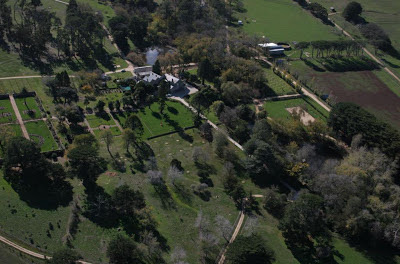When I was trawling the Net for information on the Bishop's Palace, I came across a reference to the sale of the historic Ercildoune.
Thomas Livingstone-Learmonth (1783-1869), a strict Presbyterian, was a merchant in Edinburgh, Scotland who made a great deal of money in the service of the British East India Company. Thomas was a merchant in Hobart, Tasmania in 1835 with his four sons John, Thomas Jnr., Somerville and Andrew. Thomas and Somerville were still in their teens when they were sent by their father to Victoria to find suitable sheep farming land. Leaders in the pastoral settlement of the Port Phillip district, they first settled at the head of the Barwon River, Geelong, and then at Buninyong followed by Burrumbeet in 1838. In 1849 Ercildoun was licensed in the names of John, Thomas Junior and Somerville. Erection of the house started in 1840 and additions added until it was finally completed in 1858-59.
Ercildoun became one of the more famous stately properties in rural Victoria. The Scottish baronial homestead with gabled wings and crow stepped and castellated parapets, was built of granite hewn from the slopes of Mount Ercildoun and handmade bricks from a kiln on the property.
Thomas Livingstone-Learmonth (1783-1869), a strict Presbyterian, was a merchant in Edinburgh, Scotland who made a great deal of money in the service of the British East India Company. Thomas was a merchant in Hobart, Tasmania in 1835 with his four sons John, Thomas Jnr., Somerville and Andrew. Thomas and Somerville were still in their teens when they were sent by their father to Victoria to find suitable sheep farming land. Leaders in the pastoral settlement of the Port Phillip district, they first settled at the head of the Barwon River, Geelong, and then at Buninyong followed by Burrumbeet in 1838. In 1849 Ercildoun was licensed in the names of John, Thomas Junior and Somerville. Erection of the house started in 1840 and additions added until it was finally completed in 1858-59.
 |
| The home and gardens from the air |
Set on 73 hectares the two-storey homestead comprises nine bedrooms and three bathrooms, and features a ballroom and a library. A self-contained three-bedroom residence in the former maid's quarters is at the rear of the homestead. 22 houses were built on the property for 64 men and their families with its own school and gaol.
The Learmonths were also outstanding gardeners and created a network of paths and cultivated garden beds including oaks, elms, poplars, chestnuts and plane trees in pots brought from Scotland. They were leaders in the use of machinery with threshing and winnowing machines and had a flour mill powered by a water-mill which ground their wheat.
 |
| The main door with the 1838 keystone |
The Learmonth family history dates back to the 13th century. Ercildoune has a copy of the tower or keep situated in the Borders region of Scotland to the west of the homestead. They apparently brought back to Ercildoun a stone from this keep and it was inscribed and placed in to the replica built here: ‘Stone from Rhymer’s Tower at Earlston, Scotland, occupied in the 13th century by Thomas the Rhymer’ whose direct line is Mary Livingstone a favourite maid of Mary Queen of Scots and the African explorer.
Thomas eventually married and sadly a daughter died at only a few weeks of age in 1858 and she is buried in the Ercildoun Cemetery that closed for interments in 1895.
In 1873 the Learmonths sold the station to Sir
Samuel Wilson on a walk-in walk-out basis. Sir Samuel with his brothers - John and Charles, had bought Longerenong in 1856. He created an irrigation system that became the forerunner of today’s Mallee-Wimmera water gravitation scheme. He established a Sambar deer park on Mount Ercildoune and released chital deer into the Wimmera in the 1860’s from his Longerenong property.
 |
| The ballroom with the balcony in the ceiling |
 |
| The ballroom's balcony |
 |
| A section of the walled gardens |
Dame Nellie Melba leased Ercildoune in 1907 and had a tennis court built for her use.
Sir Alan Currie bought Ercildoune from the Estate of Sir Samuel in 1920-21., and Lady Currie carried on the property after Major Currie died in 1942, until she too passed away on 1962.
John and Christine Dever from Melbourne purchased the property in 1999, restored it and were looking to sell it for about $4 million in May this year.
(Historical information & photographs from the Ercildoune website)
(Historical information & photographs from the Ercildoune website)






No comments:
Post a Comment